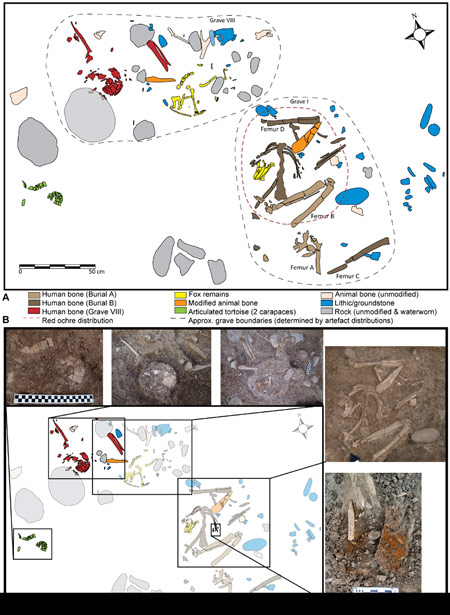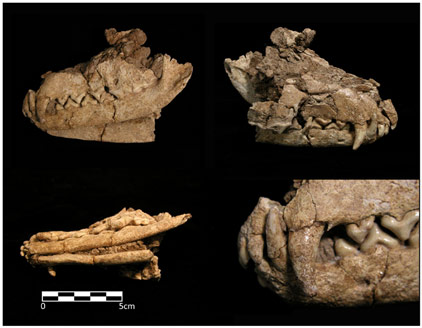Did Mesolithic People Prefer Foxes to Dogs as Pets?
Foxes may be regarded today in the United Kingdom by many people as vermin, particularly with the case recently of a fox attacking a baby. Indeed, the traditional fox hunting scene of a fox being chased by a pack of dogs still adorns many a tea-towel and other such apparel, but evidence found in an archaeological dig in the Middle East country of Jordan suggests that at least one fox was man’s (or woman’s) best friend long before dogs became prominent.
Fox Bones Found in Mesolithic Grave
Foxes are members of the Canidae family, the same family as dogs (canines), they are generally omnivorous and usually no bigger than a Springer Spaniel, the Red Fox for example, (Vulpes vulpes). Regarded as intelligent, cunning and resourceful animals, they are found on virtually every continent (having been introduced to Australia) and they are common subjects for folklore and country tales.
Mesolithic peoples may have preferred the fox to the dog as a pet, a new study in the online scientific journal PLoS One suggests. Researchers examining graves and grave goods at a prehistoric burial ground in the country of Jordan have discovered a grave in which a fox was buried alongside a human. Perhaps this was the household pet.
The research team (based at Cambridge University, UK) have postulated that this is evidence of some sort of emotional bond between human beings and foxes. The fox may have been buried along side its master or mistress so that the two could travel to the afterlife together.
Fox Bones
Although, the bones may not be proof of an emotional link between a person and a fox, if people were domesticating foxes at the time the person was buried, it suggests that foxes were forming an association with people long before dogs came onto the scene. The graves are located at Uyun-al-Hammam, in northern Jordan. The site is approximately 16,500 years old and depicts a human culture that was becoming more sedentary, moving away from a hunter-gatherer lifestyle and becoming more involved with agriculture. The fox/human grave is approximately 4,000 years older than the earliest human-dog burial and 7,000 years earlier than anything else similar found in Europe.
Studying the Burial Site
The study of the burial site, reveals a growing cultural sophistication, more closely associated with the later Neolithic age. Foxes (the Red Fox) were common in that area of the Middle East in the Mesolithic (as they are today), perhaps they played a role in keeping man’s first grain harvests safe from rates and mice whilst it was in storage. However, the relationship between mankind and foxes does not seem to have lasted, the more friendly and less timid dogs seem to have taken over sometime in the Neolithic.
A Diagram Showing the Layout of the Human/Fox Graves

Picture credit: PLoS One – Maher et al.
The picture shows a diagram of the grave area and highlighted areas with accompanying photographs providing more detail. The site shows evidence of the grave being opened and the human body being relocated and buried close by. The body of the fox was also removed from the first grave and reburied with the human.
Body of the Fox Reburied
Commenting on this, Dr Lisa Maher from the Leverhulme Centre for Human Evolutionary Studies (Cambridge University) stated:
“The burial site provides intriguing evidence of a relationship between humans and foxes which predates any comparable example of animal domestication. What we appear to have found is a case where a fox was killed and buried with its owner.”
Dr Maher went onto add:
“Later, the grave was reopened for some reason and the human’s body was moved. But because the link between fox and human had been significant, the fox was moved as well, so that the person, or people, would still be accompanied by it in the afterlife.”
Photographs of the Fox Skull from the Grave
Picture credit: PLoS One – Maher et al.
The photographs show various views (lateral views, close up of lateral views and ventral view) of the prepared and conserved fox skull found at the Uyun-al-Hammam site. The skulls of a number of canines were studied by the research team in order to identify the species and the skull/skeleton from the grave has been identified as a Red Fox (Vulpes vulpes).
It is interesting to think how things may have turned out for the foxes if we humans had not started domesticating chickens and other birds. Foxes are renowned in many cultures for their ability to break into and cause havoc in chicken coups, perhaps as we became more successful at domesticating other animals so our relationship with the fox was doomed.
The scientific paper: “A Unique Human-Fox Burial from a Pre-Natufian Cemetery in the Levant (Jordan)” by Lisa A. Maher, Jay T. Stock, Sarah Finney, James J. N. Heywood, Preston T. Miracle, Edward B. Banning published in PLoS One.
Visit Everything Dinosaur’s award-winning website: Everything Dinosaur.







Leave A Comment